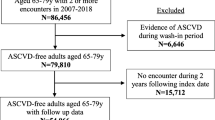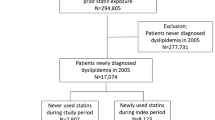Abstract
To compare impact of incident diabetes on atherosclerotic cardiovascular disease (ASCVD) risk among postmenopausal women according to statin use. Prospective data from 120,499 postmenopausal women without prevalent diabetes or cardiovascular disease at baseline from the Women’s Health Initiative were used. Incident diabetes was self-reported annually and defined as treatment with pills or injectable medication for diabetes. Current statin use was determined at enrollment and years 1, 3, 6, 9 and 13.5 in the three clinical trial arms, and at baseline, year 3, and 13.5 for the observational study. The primary outcome was incident ASCVD events, self-reported annually and adjudicated by blinded local and central physicians. Incident diabetes and statin use status were fitted as time-varying covariates in Cox regression models to assess ASCVD risk during an average follow-up of 13.6 years. For those not on statins at the time of diabetes diagnosis, there was a 42 % increased risk of ASCVD [hazard ratio (HR) 1.42, 95 % CI 1.28–1.58] among women with incident diabetes versus those without diabetes. Among women on statins, there was a 39 % increased risk of ASCVD (HR 1.39, 95 % CI 1.12–1.74) in women with incident diabetes versus those without diabetes. The increased ASCVD risk due to diabetes was similar between women before or after initiating statins (P = 0.89). Whether diabetes was diagnosed before or after statin use did not alter the increased risk of ASCVD associated with diabetes. Mitigating the increased incidence of diabetes in statin users could increase the ASCVD benefit-to-risk ratio of statins.



Similar content being viewed by others
References
Eldor R, Raz I. American Diabetes Association indications for statins in diabetes: is there evidence? Diabetes Care. 2009;32(Suppl 2):S384–91.
Ma Y, Hebert J, Ebbeling C, Ockene I. International aspects of coronary heart disease epidemiology. In: Becker RC, Alpert JS, editors. Cardiovascular medicine-practice and management. London: Arnold; 2001.
Ma Y, Hebert JR, Balasubramanian R, et al. All-cause, cardiovascular, and cancer mortality rates in postmenopausal white, black, hispanic, and asian women with and without diabetes in the United States: the women’s health initiative, 1993–2009. Am J Epidemiol. 2013;178:1533–41.
Stone NJ, Robinson JG, Lichtenstein AH, et al. 2013 ACC/AHA guideline on the treatment of blood cholesterol to reduce atherosclerotic cardiovascular risk in adults: a report of the American College of Cardiology/American Heart Association Task Force on Practice Guidelines. Circulation. 2014;129:S1–45.
American Diabetes A (8). Cardiovascular disease and risk management. Diabetes Care. 2015;38(Suppl):49–57.
Sattar N, Preiss D, Murray HM, et al. Statins and risk of incident diabetes: a collaborative meta-analysis of randomised statin trials. Lancet. 2010;375:735–42.
Preiss D, Seshasai SR, Welsh P, et al. Risk of incident diabetes with intensive-dose compared with moderate-dose statin therapy: a meta-analysis. JAMA J Am Med Assoc. 2011;305:2556–64.
Waters DD, Ho JE, DeMicco DA, et al. Predictors of new-onset diabetes in patients treated with atorvastatin: results from 3 large randomized clinical trials. J Am Coll Cardiol. 2011;57:1535–45.
Swerdlow DI, Preiss D, Kuchenbaecker KB et al. HMG-coenzyme A reductase inhibition, type 2 diabetes, and bodyweight: evidence from genetic analysis and randomised trials. Lancet 2014;385:351–61.
Navarese EP, Buffon A, Andreotti F, et al. Meta-analysis of impact of different types and doses of statins on new-onset diabetes mellitus. Am J Cardiol. 2013;111:1123–30.
Mora S, Glynn RJ, Hsia J, MacFadyen JG, Genest J, Ridker PM. Statins for the primary prevention of cardiovascular events in women with elevated high-sensitivity C-reactive protein or dyslipidemia: results from the Justification for the Use of Statins in Prevention: an Intervention Trial Evaluating Rosuvastatin (JUPITER) and meta-analysis of women from primary prevention trials. Circulation. 2010;121:1069–77.
Ridker PM, Pradhan A, MacFadyen JG, Libby P, Glynn RJ. Cardiovascular benefits and diabetes risks of statin therapy in primary prevention: an analysis from the JUPITER trial. Lancet. 2012;380:565–71.
The Women’s Health Initiative Study Group. Design of the women’s health initiative clinical trial and observational study. Control Clin Trials. 1998;19:61–109.
Margolis K, Qi L, Brzyski R, et al. Validity of diabetes self-reports in the women’s health initiative: comparison with medication inventories and fasting glucose measurements. Clin Trials. 2008;5(3):240–7.
Jackson JM, DeFor TA, Crain AL, et al. Validity of diabetes self-reports in the Women’s Health Initiative. Menopause. 2014;21:861–8.
Patterson RE, Kristal AR, Tinker LF, Carter RA, Bolton MP, Agurs-Collins T. Measurement characteristics of the Women’s Health Initiative food frequency questionnaire. Ann Epidemiol. 1999;9:178–87.
Kennedy ET, Ohls J, Carlson S, Fleming K. The Healthy Eating Index: design and applications. J Am Diet Assoc. 1995;95:1103–8.
McCullough ML, Willett WC. Evaluating adherence to recommended diets in adults: the Alternate Healthy Eating Index. Public Health Nutr. 2006;9:152–7.
McCullough ML, Feskanich D, Stampfer MJ, et al. Diet quality and major chronic disease risk in men and women: moving toward improved dietary guidance. Am J Clin Nutr. 2002;76:1261–71.
Belin RJ, Greenland P, Allison M, et al. Diet quality and the risk of cardiovascular disease: the Women’s Health Initiative (WHI). Am J Clin Nutr. 2011;94:49–57.
Qiao Y, Tinker L, Olendzki BC, et al. Racial/ethnic disparities in association between dietary quality and incident diabetes in postmenopausal women in the United States: the Women’s Health Initiative 1993–2005. Ethn Health 2013;19:328–47.
Cox D. Regression models and life-tables. J Roy Stat Soc. 1972;34:187–220.
Hosmer DW, Lemeshow S, May S. Applied survival analysis: regression modeling of time to event data. New York: Wiley; 2008.
Grundy SM, Cleeman JI, Daniels SR, et al. Diagnosis and management of the metabolic syndrome: an American Heart Association/National Heart, Lung, and Blood Institute Scientific Statement. Circulation. 2005;112:2735–52.
Ford ES, Li C, Zhao G. Prevalence and correlates of metabolic syndrome based on a harmonious definition among adults in the US. J Diabetes. 2010;2:180–93.
Cholesterol Treatment Trialists’ CTT C. The effects of lowering LDL cholesterol with statin therapy in people at low risk of vascular disease: meta-analysis of individual data from 27 randomised trials. Lancet 2012;380:581–90.
Kostis WJ, Cheng JQ, Dobrzynski JM, Cabrera J, Kostis JB. Meta-analysis of statin effects in women versus men. J Am Coll Cardiol. 2012;59:572–82.
Cholesterol Treatment Trialists C. Efficacy and safety of LDL-lowering therapy among men and women: meta-analysis of individual data from 174000 participants in 27 randomised trials. Lancet 2015;385:1397–1405.
Acknowledgments
Y.M. and G.M.P wrote the manuscript and researched data. A.L.C., J.E.M., L.S.P., S.L., C.E., M.L., L.W.M, B.V.H, R.B., C.E.B., I.S.O., S.R.S., J.K.O., L.T, R.N., and J.R. contributed to the discussion and reviewed and edited the manuscript. C.A. and K. H performed data analyses and reviewed and edited the manuscript. The Women’s Health Initiative (WHI) program is funded by the National Heart, Lung, and Blood Institute, National Institutes of Health, US Department of Health and Human Services through contracts N01WH22110, 24152, 32100-2, 32105-6, 32108-9, 32111-13, 32115, 32118-32119, 32122, 42107-26, 42129-32, and 44221. Our investigation also was supported in part by 5R01HL122241-02. A list of WHI investigators is available in Supplementary Data online. The authors thank the principal investigators of all WHI clinical centers and the data coordinating center for their contribution to the study. They are also indebted to the dedicated and committed participants of the WHI.
Author information
Authors and Affiliations
Corresponding author
Appendix
Appendix
See Tables 3, 4, 5, 6, 7 and 8.
Post hoc test of comparisons
Comparison | Wald Chi-square | df | P value |
|---|---|---|---|
Across 3 diabetes groups | 3.4597 | 2 | 0.177 |
Pairwise tests | |||
Diabetes before statin (if any) and diabetes after statin (low potency) | 1.9568 | 1 | 0.162 |
Diabetes before statin (if any)and diabetes after statin (high potency) | 1.2013 | 1 | 0.273 |
Diabetes after statin (low potency) and diabetes after statin (high potency) | 3.4592 | 1 | 0.063 |
Rights and permissions
About this article
Cite this article
Ma, Y., Persuitte, G.M., Andrews, C. et al. Impact of incident diabetes on atherosclerotic cardiovascular disease according to statin use history among postmenopausal women. Eur J Epidemiol 31, 747–761 (2016). https://doi.org/10.1007/s10654-016-0153-7
Received:
Accepted:
Published:
Issue Date:
DOI: https://doi.org/10.1007/s10654-016-0153-7




